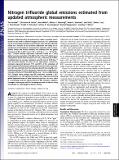Nitrogen trifluoride global emissions estimated from updated atmospheric measurements
Author(s)
Arnold, Tim; Harth, C. M.; Muhle, Jens; Manning, Alistair J.; Salameh, Peter K.; Kim, Jooil; Steele, L. Paul; Petrenko, Vasilii V.; Severinghaus, Jeffrey P.; Baggenstos, Daniel; Weiss, Ray F.; Ivy, Diane J; ... Show more Show less
DownloadArnold-2013-Nitrogen trifluoride.pdf (537.8Kb)
PUBLISHER_POLICY
Publisher Policy
Article is made available in accordance with the publisher's policy and may be subject to US copyright law. Please refer to the publisher's site for terms of use.
Terms of use
Metadata
Show full item recordAbstract
Nitrogen trifluoride (NF[subscript 3]) has potential to make a growing contribution to the Earth’s radiative budget; however, our understanding of its atmospheric burden and emission rates has been limited. Based on a revision of our previous calibration and using an expanded set of atmospheric measurements together with an atmospheric model and inverse method, we estimate that the global emissions of NF[subscript 3 ] in 2011 were 1.18 ± 0.21 Gg⋅y[superscript −1], or ∼20 Tg CO[subscript 2]-eq⋅y[superscript−1] (carbon dioxide equivalent emissions based on a 100-y global warming potential of 16,600 for NF[subscript 3]). The 2011 global mean tropospheric dry air mole fraction was 0.86 ± 0.04 parts per trillion, resulting from an average emissions growth rate of 0.09 Gg⋅y[superscript −2] over the prior decade. In terms of CO[subscript 2] equivalents, current NF[subscript 3] emissions represent between 17% and 36% of the emissions of other long-lived fluorinated compounds from electronics manufacture. We also estimate that the emissions benefit of using NF[subscript 3] over hexafluoroethane (C[subscript 2]F[subscript 6]) in electronics manufacture is significant—emissions of between 53 and 220 Tg CO[subscript 2]-eq⋅y[superscript −1] were avoided during 2011. Despite these savings, total NF[subscript 3] emissions, currently ~10% of production, are still significantly larger than expected assuming global implementation of ideal industrial practices. As such, there is a continuing need for improvements in NF[subscript 3] emissions reduction strategies to keep pace with its increasing use and to slow its rising contribution to anthropogenic climate forcing.
Date issued
2013-01Department
Massachusetts Institute of Technology. Department of Earth, Atmospheric, and Planetary SciencesJournal
Proceedings of the National Academy of Sciences of the United States of America
Publisher
National Academy of Sciences (U.S.)
Citation
Arnold, T., C. M. Harth, J. Muhle, A. J. Manning, P. K. Salameh, J. Kim, D. J. Ivy, et al. “Nitrogen trifluoride global emissions estimated from updated atmospheric measurements.” Proceedings of the National Academy of Sciences 110, no. 6 (February 5, 2013): 2029-2034.
Version: Final published version
ISSN
0027-8424
1091-6490